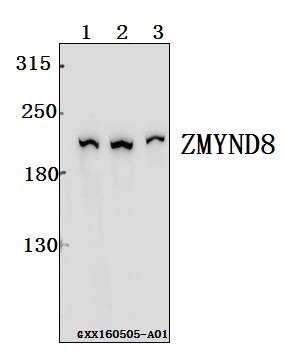Product Name :
ZMYND8 polyclonal antibody Background :
Members of the protein kinase C (PKC) family play a key regulatory role in a variety of cellular functions including cell growth and differentiation, gene expression, hormone secretion and membrane function. Receptor for activated C kinases, termed RACKs, are intracellular receptors for activated PKC that serve as anchors and may be involved in the activation-induced translocation of PKC. RACK7 (receptor for activated C kinase 7), also known as ZMYND8 (zinc finger MYND domain-containing protein 8), PRKCBP1 (protein kinase C (PKC)-binding protein 1) or PRO2893, is a widely expressed protein with predominant expression in pancreas, lung, placenta and brain. RACK7 contains one bromodomain, one PHD-type zinc finger, one MYND-type zinc finger and one PWWP domain. Via its C-terminus, RACK7 interacts with PKC ∫ and is believed to play a role in PKC signaling and function as a transcription regulator. In response to DNA damage, RACK7 is phosphorylated by ATM or ATR. In addition, multiple isoforms exist for RACK7. Product :
Rabbit IgG, 1mg/ml in PBS with 0.02% sodium azide, 50% glycerol, pH7.2 Storage&Stability :
Store at 4°C short term. Aliquot and store at -20°C long term. Avoid freeze-thaw cycles. Specificity :
ZMYND8 polyclonal antibody detects endogenous levels of ZMYND8 protein. Immunogen :
Synthetic peptide, corresponding to amino acids 586-630 of Human ZMYND8 Conjugate :
Unconjugated Modification :
Unmodification
ZMYND8 polyclonal antibody Background :
Members of the protein kinase C (PKC) family play a key regulatory role in a variety of cellular functions including cell growth and differentiation, gene expression, hormone secretion and membrane function. Receptor for activated C kinases, termed RACKs, are intracellular receptors for activated PKC that serve as anchors and may be involved in the activation-induced translocation of PKC. RACK7 (receptor for activated C kinase 7), also known as ZMYND8 (zinc finger MYND domain-containing protein 8), PRKCBP1 (protein kinase C (PKC)-binding protein 1) or PRO2893, is a widely expressed protein with predominant expression in pancreas, lung, placenta and brain. RACK7 contains one bromodomain, one PHD-type zinc finger, one MYND-type zinc finger and one PWWP domain. Via its C-terminus, RACK7 interacts with PKC ∫ and is believed to play a role in PKC signaling and function as a transcription regulator. In response to DNA damage, RACK7 is phosphorylated by ATM or ATR. In addition, multiple isoforms exist for RACK7. Product :
Rabbit IgG, 1mg/ml in PBS with 0.02% sodium azide, 50% glycerol, pH7.2 Storage&Stability :
Store at 4°C short term. Aliquot and store at -20°C long term. Avoid freeze-thaw cycles. Specificity :
ZMYND8 polyclonal antibody detects endogenous levels of ZMYND8 protein. Immunogen :
Synthetic peptide, corresponding to amino acids 586-630 of Human ZMYND8 Conjugate :
Unconjugated Modification :
Unmodification
-
 Western blot (WB) analysis of ZMYND8 polyclonal antibody at 1:500 dilution Lane1:Jurkat whole cell lysate(40ug) Lane2:A549 whole cell lysate(40ug) Lane3:Panc1 whole cell lysate(40ug)
Western blot (WB) analysis of ZMYND8 polyclonal antibody at 1:500 dilution Lane1:Jurkat whole cell lysate(40ug) Lane2:A549 whole cell lysate(40ug) Lane3:Panc1 whole cell lysate(40ug)
Bioworld Biotech only provide peptides for our antibodies and do not provide additional peptide customization services.
Price/Size :
USD 368/1mg/vial
Tips:
For phospho antibody, we provide phospho peptide(0.5mg) and non-phospho peptide(0.5mg).Describe :
Blocking peptides are peptides that bind specifically to the target antibody and block antibody binding. These peptide usually contains the epitope recognized by the antibody. Antibodies bound to the blocking peptide no longer bind to the epitope on the target protein. This mechanism is useful when non-specific binding is an issue, for example, in Western blotting (WB) and Immunohistochemistry (IHC). By comparing the staining from the blocked antibody versus the antibody alone, one can see which staining is specific; Specific binding will be absent from the western blot or IHC performed with the neutralized antibody.Formula:
Synthetic peptide was lyophilized with 100% acetonitrile and is supplied as a powder. Reconstitute with 0.1 ml DI water for a final concentration of 10 mg/ml.The purity is >90%,tested by HPLC and MS.
Storage:
The freeze-dried powder is more stable. For short time at 2-8°C. For long term storage store at -20°C.
Note :
This product is for research use only (RUO only). Not for use in diagnostic or therapeutic procedures.
 ZMYND8 polyclonal antibody
ZMYND8 polyclonal antibody  Datasheet
Datasheet COA
COA MSDS
MSDS SHIP
SHIP